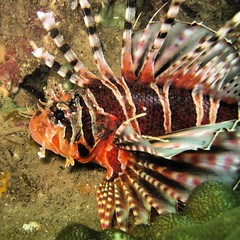 Lionfish Quick Care Facts:
Lionfish Quick Care Facts:
Environment: Tropical 72-82°F (22-28°C)
pH: 8.1 to 8.4
KH: 1.020 – 1.025
Diet: Carnivorous
Breeding: Egg layers
Lionfish are some of the most impressive aquarium fish around, growing up to 15 inches in length. They also carry an element of danger, as many of their spines are poisonous.
The Lionfish Environment
Large tanks are required for this tropical fish. They need plenty of space and are likely to eat other, smaller fish, even of the same species. The tanks should be at least 30 gallons, but much larger if you have a larger species. The dwarf fish will be fine in 30 gallons.
While lighting can be standard, lions do appreciate caves and lots of overhangs in the tank. They like to “perch” sometimes and will frequently hang out with their heads in crevices. Give them a nice substrate bottom to enjoy, as well.
The tank must be covered, as lions will jump out. Also, you should be aware that they produce a lot of waste, so require a heavy duty filtration system.
Feeding Your Lionfish
These are hunting fish and they prefer to feed at night. Adult fish only require feeding two or three times a week, while babies will need more regular food. You can give them small fish, shrimp and small pieces of frozen tuna or other fish. Only feed until you see a little bulge in the lion’s belly.
Breeding Lionfish
In the wild, these fish only group together when they are about to spawn. In both tank and sea, the males will become very aggressive and turn dark in color. The females become a lighter color.
The mating dance will occur if you leave the fish alone. The female will lay tubes of eggs which will hatch out into larvae in around 36 hours if they are fertilized by a male.
Common Lionfish Diseases
These fish are not likely to get sick, but they can be prone to bloat if they are fed large pieces of food. The food can putrefy in their gut, causing a buildup of gases.
The other disease that may find its way into your tank is Saltwater Fish Disease.